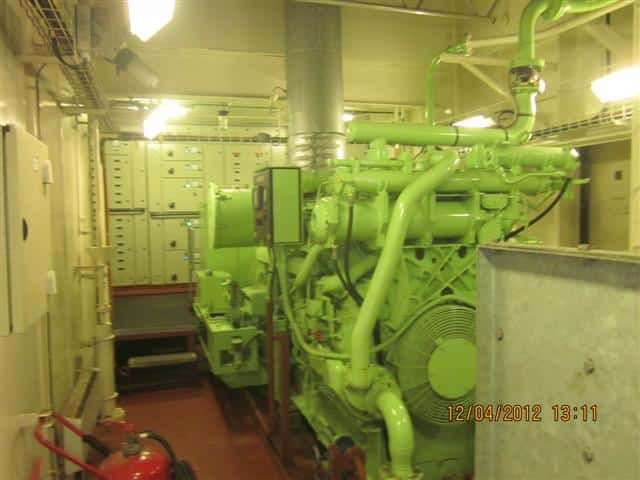How is Power Generated and Supplied on a Ship?
A ship is like a floating city with all the privileges enjoyed by any normal land city. Just like a conventional city, the ship also requires all the basic amenities to sustain life on board; the chief among them is power or electricity. In this article we will learn as to how power is generated and supplied on board a ship.
Power generation On board
Shipboard power is generated using a prime mover and an alternator working together. For this an alternating current generator is used on board. The generator works on the principle that when a magnetic field around a conductor varies, a current is induced in the conductor.
The generator consists of a stationary set of conductors wound in coils on an iron core. This is known as the stator. A rotating magnet called the rotor turns inside this stator producing magnetic field. This field cuts across the conductor, generating an induced EMF or electro-magnetic force as the mechanical input causes the rotor to turn.
The magnetic field is generated by induction (in a brushless alternator) and by a rotor winding energized by DC current through slip rings and brushes. Few points to be noted about power on board are :
- AC, 3 phase power is preferred over DC as it gives more power for the same size.
- 3 phases is preferred over single phase as it draws more power and in the event of failure of one phase, other 2 can still work.
Power Distribution on board
The Power Distributed on board a ship needs to be supplied efficiently throughout the ship. For this the power distribution system of the ship is used.

A shipboard distribution system consists of different component for distribution and safe operation of the system. They are:
- Ship Generator consisting of prime mover and alternator
Main switch board which is a metal enclosure taking power from the diesel generator and supplying it to different machinery. - Bus Bars which acts as a carrier and allow transfer of load from one point to another. Circuit breakers which act as a switch and in unsafe condition can be tripped to avoid breakdown and accidents. Fuses as safety device for machinery.
- Transformers to step up or step down the voltage. When supply is to be given to the lighting system a step down transformer is used in the distribution system.
- In a power distribution system, the voltage at which the system works is usually 440v.
- There are some large installations where the voltage is as high as 6600v.
- Power is supplied through circuit breakers to large auxiliary machinery at high voltage.
- For smaller supply fuse and miniature circuit breakers are used.
- The distribution system is three wires and can be neutrally insulated or earthed.
- Insulated system is more preferred as compare to earthed system because during an earth fault essential machinery such as steering gear can be lost.
Emergency Power
In case of the failure of the main power generation system on the ship, an emergency power system or a standby system is also present. The emergency power supply ensures that the essential machinery and system continues to operate the ship.
Emergency power can be supplied by batteries or an emergency generator or even both systems can be used.
Rating of the emergency power supply should be made in such a way that it provides supply to the essential systems of the ship such as
a) Steering gear system
b) Emergency bilge and fire p/p
c) Watertight doors.
d) Fire fighting system.
e) Ships navigation lights and emergency lights.
f) Communication and alarm system.
Emergency generator is normally located outside the machinery space of the ship. This is done mainly to avoid those emergency situations wherein access to the engine room is not possible. A switch board in the emergency generator room supplies power to different essential machinery.
You may also like to read – What is Marine Electricity And How It is Generated?
Reference: Introduction to marine engineering by D.A Taylor
Do you have info to share with us ? Suggest a correction

About Author
An ardent sailor and a techie, Anish Wankhede has voyaged on a number of ships as a marine engineer officer. He loves multitasking, networking, and troubleshooting. He is the one behind the unique creativity and aesthetics at Marine Insight.
Subscribe To Our Newsletters
By subscribing, you agree to our Privacy Policy and may receive occasional deal communications; you can unsubscribe anytime.





Thank you for your kind appreciation, it really increases my enthusiasm and zeal to write better. If you want to read about any particular topic, you can contact me on anishw@marineinsight.com
Very nice article and well presented,I would like to add the following as additional info,
The class requirement for the starting of Emergency Generator says, there should be two independent means of starting, usually one means is Battery and the other is either hydraulic or by means of compressed spring or pneumatic (air bottle). Sometimes you have two banks of battery. now just having two banks of battery is not acceptable, in addition you are supposed to have a starter motor as spare and that too should be stored in the Emergency Generator room.
Thank you for providing the additional info.
Sir
I competed Btech EEE,want to join merchant navy what are the procedures ?? Please give me an advice…I have 2 years experience in transmission field…
You can join merchant navy as Electro technical officer.
Thank you sir, I acknowledge you Effort.am still a young guy trying to make way into the maritime sector as an engineer though still studying,I will like you to educate me on the ways to be a good engineer thanks
Please sir, I am auto electrician for about 11 years and I want to marine electrician how can I join,
sir i m a wpr now want to be an engineer. could u pls tell me the procedures to appear in the exam in india.
Please ask this in our forum- https://forums.marineinsight.com under career section
Can i assume that most ships will have a 440 volt AC supply in the engine room.
Do the engine rooms have step down transformers to supply rectified low voltage DC current?
Would this be ‘standard’? Or is everything run from the 440 volt AC supply?
how magnetic field is produced by induction?? and in emergency generator which prime mover is used
Nice article… But i want to understand is there any way the ocean current cn help genarate electricity in d ship
@ Modesta: No such machinery or systems are installed which can generate electricity form ocean current. A ship needs to deliver cargo from point A to point B and can’t be dependent on the ocean for electricity as it plays a vital role in propulsion and carriage of the cargo.
Hello Good people,
Thank you for the valuable information. I just want to ask if batteries are used in a ship? And also in ports except for running the forklifts.
Sir. Where do we use a UPS in ship and what is its purpose?
@Amanuel: Batteries are one of the energy sources available onboard vessels which are used in case of blackout and emergency situations on board a ship. These batteries are used for low voltage dc system like bridge navigational instruments and thus need to be kept charged to be used in case of any need of temporary power.
Sir, is wiring of household and ship are the same from their source of power to the consuming devices?
thank you sir ,i have appriciated.i am go to next vessel using for your technical knowledge.allwaysI taken YOUR TECHNICAL KNOWLEDGE
sir i want to know the area of the generator room for container vessel
Thanks for useful information
Very nice
Would you please suggest me good college in south india for ETO?
Sir, thanks for the post. I have doubt. Normally in land, we have reference point for earthing. How is earthing done in shipping?
Where transformer is located in ship engine room and in forward .what is the purpose of transformer used in forward of the ship?
@Kumaraguru: Transformers can be located inside the engine room (near control room platform). The forward transformers are installed usually for bow thrusters.
the AC power is preferred to DC power
Hello,
Can somebody advise what kind of power is can be available on a ship? I have a freight that needs constant power. Are their services that can guarantee constant power?
I’m thinking about services for reef shipments.
Thanks
@Martijn: yes, They provide continuous power.
PLEASE ELABORATE-The magnetic field is generated by induction (in a brushless alternator) .
Hello,
Really a very good write up for young mariners as well as for reference.
@N.V Sajitha: Thank you for your support.
Hi, I like to know for US and Japan vessels using 1P 110V, what is the slow blow fuse amp rating?
I have a multi power 110V / 230V welding machine. On 230V it requires 16A and on 110V it requires 32A. I am wondering if on 1P 110V, does it have 32A slow blow fuse?
Thanks.
Please help me out, electral power on board ship is generated at what voltage and current?
@Josephine: It is usually 3phase, 60Hz, 440 Volts
Very useful information,in fact all doubts get cleared here…